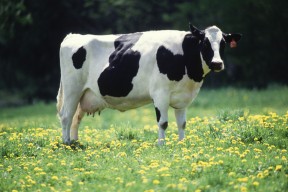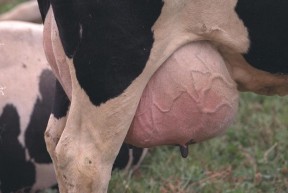Human Impact on Cattle
The Last 10,000 Years.
The most prominent changes to cattle from their wild progenitor are rather typical of domesticated animals (Velton, 2007). Reduced body size, juvenilized features, and docility were likely characteristics of early domesticated cattle. But along with reduced body size is an increase in meatiness and udder size to maximize the extraction of beef and milk. Particularly interesting is the emergence of obedience. While aurochs likely had simple forms of social structure with dominant males and females and “subordinates.” However, as the documentary Holy Cow depicts, cattle move like sheep to whims and demands of their human owners (Holy cow, 2004). The wild auroch, once controlled by humans via ropes, nose piercings, and castration (As a side note, castrated cattle used for labor or transport are typically called oxen), has been reduced to a malleable and docile creature that lives at bay to the waving hand of a single human.
The Last 500 Years.
Most of us in the United States are accustomed cows that appear a certain away. The stereotypical cow appears, to us, as having a “black-pied” pattern as shown below. This is the Holstein Fresian breed of cattle originally bred in regions of Northern and Eastern Europe for milk production. Other common patterns include brown-pied, brown, and black. These typically fall into the Hereford and Angus cattle breeds, which are typically bred for beef production. However, at one point, hundreds of distinct patterns existed throughout Europe (Ajmone-Marsan, 2010). During the 18th century, catastrophic disease swept through Northern Europe, particularly in the Netherlands, which led to the import of black-pied cattle in large numbers. I speculate that there was no particular preference for black-pied cattle other than their resistance to diseases killing other populations.
The Last 50 Years.
The last century has been characterized by the “industrialization” of the cow in the developed world. No longer is the cow treated as an animal. Instead, it is treated as nothing more than a resource provider, similarly to the way we perceive gas stations. The human-cow relationship has deteriorated into pure exploitation by humans. In essence, the chages to the cow in the last 50 years are more in how they are treated and used than in how they appear or behave, aside from ever-increasing milk production and udder size.

Heck cow
Genetic engineering and artificial insemination have produced cattle “superbreeds” that produce milk in quantities unimaginable and unnecessary in nature. For instance, between 1970 and 2005, the average quantity of milk produced by a cow in the United States increased from 825 gallons to over 1,250 gallons (Velton, 2007), an increase of over 50%. In addition, cows are often injected with a growth hormone that boosts milk production another 10 to 15 percent. This has caused cattle serious strain, as the amount of energy exerted by a cow to produce three to four gallons of milk per day has been compared to a human running for six hours per day. As a result cattle become worn out, milk yield declines, and they are slaughtered at an earlier age (often within three years). Take a look at the below figure to see the likely difference in udder size between an auroch and a taurine cow.

